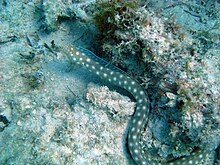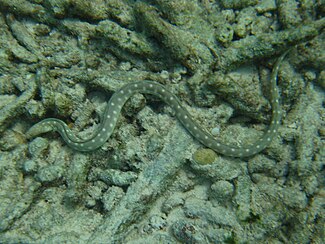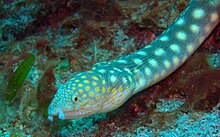| Myrichthys breviceps | |
|---|---|

| |
|
Scientific classification
| |
| Domain: | Eukaryota |
| Kingdom: | Animalia |
| Phylum: | Chordata |
| Class: | Actinopterygii |
| Order: | Anguilliformes |
| Family: | Ophichthidae |
| Genus: | Myrichthys |
| Species: | M. breviceps
|
| Binomial name | |
| Myrichthys breviceps (
J. Richardson, 1848)
| |
| Synonyms | |
|
Myrichthys acuminatus | |
Myrichthys breviceps (syn. M. acuminatus), the sharptail snake-eel, is a fish species native to the Western Atlantic.
It has diffuse, yellow spots on a blueish-gray back and white belly. Spots are small on the head, larger on the body. The eel can be found along the coasts of the Caribbean sea, mainly on sea grass beds, reefs, and in clear waters. Despite being nocturnal, they can also be seen foraging during daylight. Their food source is small invertebrates like crabs.
They allow close approach by divers and can easily be photographed, but bury in the sand when bothered. [1]


References
- ^ Humann, P. and Deloach, N.: Reef fish identification Florida Caribbean Bahamas, Jacksonville (Fl.), New World Publications, 3rd Printing, 2006
- Froese, Rainer; Pauly, Daniel (eds.) (2011). "Myrichthys breviceps" in FishBase. June 2011 version.
External links
- Photos of Myrichthys breviceps on Sealife Collection
| Myrichthys breviceps | |
|---|---|

| |
|
Scientific classification
| |
| Domain: | Eukaryota |
| Kingdom: | Animalia |
| Phylum: | Chordata |
| Class: | Actinopterygii |
| Order: | Anguilliformes |
| Family: | Ophichthidae |
| Genus: | Myrichthys |
| Species: | M. breviceps
|
| Binomial name | |
| Myrichthys breviceps (
J. Richardson, 1848)
| |
| Synonyms | |
|
Myrichthys acuminatus | |
Myrichthys breviceps (syn. M. acuminatus), the sharptail snake-eel, is a fish species native to the Western Atlantic.
It has diffuse, yellow spots on a blueish-gray back and white belly. Spots are small on the head, larger on the body. The eel can be found along the coasts of the Caribbean sea, mainly on sea grass beds, reefs, and in clear waters. Despite being nocturnal, they can also be seen foraging during daylight. Their food source is small invertebrates like crabs.
They allow close approach by divers and can easily be photographed, but bury in the sand when bothered. [1]


References
- ^ Humann, P. and Deloach, N.: Reef fish identification Florida Caribbean Bahamas, Jacksonville (Fl.), New World Publications, 3rd Printing, 2006
- Froese, Rainer; Pauly, Daniel (eds.) (2011). "Myrichthys breviceps" in FishBase. June 2011 version.
External links
- Photos of Myrichthys breviceps on Sealife Collection